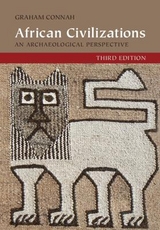
African Civilizations
An Archaeological Perspective
Seiten
2001
|
2nd Revised edition
Cambridge University Press (Verlag)
978-0-521-59309-0 (ISBN)
Cambridge University Press (Verlag)
978-0-521-59309-0 (ISBN)
- Titel erscheint in neuer Auflage
- Artikel merken
Zu diesem Artikel existiert eine Nachauflage
This edition of African Civilizations, first published in 2001, re-examines the physical evidence for developing social complexity by investigating urbanism and state formation in seven main areas of tropical Africa. Extensively illustrated and offering an extended bibliography, this book provides essential reading on the topic.
This edition of African Civilizations, first published in 2001, re-examines the physical evidence for developing social complexity in tropical Africa over the last four thousand years. Graham Connah focuses upon the archaeological research of two key aspects of complexity, urbanism and state formation, in seven main areas of Africa: Nubia, Ethiopia, the West African savanna, the West African forest, the East African coast and islands, the Zimbabwe Plateau, and parts of Central Africa. The book's main concern is to review the available evidence in its varied environmental setting, and to consider possible explanations of the developments that gave rise to it. Extensively illustrated, including new maps and plans, and offering an extended bibliography, this book provides essential reading for students of archaeology, anthropology, African history, black studies, and social geography.
This edition of African Civilizations, first published in 2001, re-examines the physical evidence for developing social complexity in tropical Africa over the last four thousand years. Graham Connah focuses upon the archaeological research of two key aspects of complexity, urbanism and state formation, in seven main areas of Africa: Nubia, Ethiopia, the West African savanna, the West African forest, the East African coast and islands, the Zimbabwe Plateau, and parts of Central Africa. The book's main concern is to review the available evidence in its varied environmental setting, and to consider possible explanations of the developments that gave rise to it. Extensively illustrated, including new maps and plans, and offering an extended bibliography, this book provides essential reading for students of archaeology, anthropology, African history, black studies, and social geography.
1. The context; 2. Birth on the Nile: the Nubian achievement; 3. The benefits of isolation: the Ethiopian Highlands; 4. An optimal zone: the West African savanna; 5. Brilliance beneath the trees: the West African forest and its fringes; 6. The edge or the centre: cities of the East African coast and islands; 7. A question of context: Great Zimbabwe and related sites; 8. In the heart of Africa: the Upemba Depression and the Interlacustrine Region; 9. What are the common denominators?
| Erscheint lt. Verlag | 29.3.2001 |
|---|---|
| Illustrationen | Douglas Hobbs |
| Zusatzinfo | 18 Maps; 17 Halftones, unspecified; 42 Line drawings, unspecified |
| Verlagsort | Cambridge |
| Sprache | englisch |
| Maße | 182 x 254 mm |
| Gewicht | 749 g |
| Themenwelt | Geisteswissenschaften ► Archäologie |
| Geschichte ► Allgemeine Geschichte ► Vor- und Frühgeschichte | |
| Geisteswissenschaften ► Geschichte ► Regional- / Ländergeschichte | |
| Sozialwissenschaften ► Soziologie ► Spezielle Soziologien | |
| ISBN-10 | 0-521-59309-3 / 0521593093 |
| ISBN-13 | 978-0-521-59309-0 / 9780521593090 |
| Zustand | Neuware |
| Haben Sie eine Frage zum Produkt? |
Mehr entdecken
aus dem Bereich
aus dem Bereich
auf den Spuren der frühen Zivilisationen
Buch | Hardcover (2023)
C.H.Beck (Verlag)
CHF 27,95
Konzepte – Methoden – Theorien
Buch | Softcover (2024)
UTB (Verlag)
CHF 55,85
Was Pompeji über uns erzählt
Buch | Hardcover (2023)
Propyläen (Verlag)
CHF 44,75



